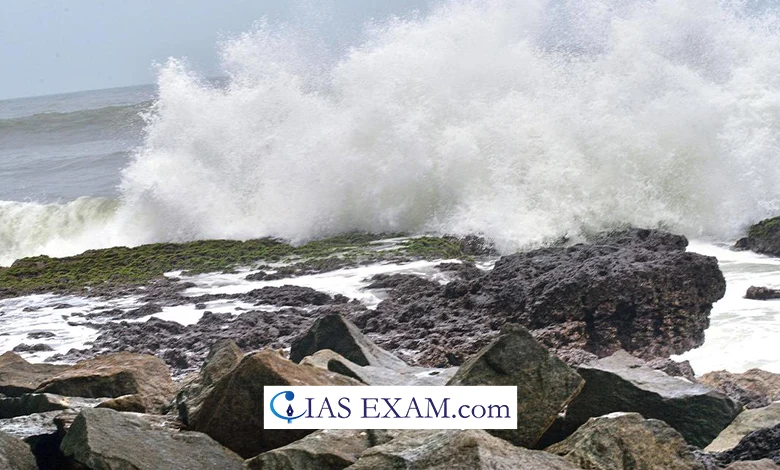Swell waves impact on coastal regions
Syllabus: Geography [GS Paper-1]

Context
Swell waves are high-energy ocean waves that can cause flooding and damage to coastal areas. They are formed by strong winds and storms in the ocean, which transfer energy to the water, creating large waves. These waves can travel long distances across the ocean and can affect coastal communities, even if the storm that generated them is far away.
Swell Waves
-
- Along with wind waves, swell waves, sometimes called ground swell, is the most commonly occurring type of surface gravity waves that can be found across the planet. Due to distance storm systems like hurricanes or continuing storms for long, cresting waves differ from local shore-generated waves that are maintained by the local winds. Such a wave can produce a significant splash much more distant from the original area of formation than the wind implies. The splash can be in a different direction from that of the wind.
- Formation: Such waves are pitched on the basis of energy which is passed from air into water during the severe tempests. Such energy propagation results in the emergence of long-waveform waves on the sea which in turn deteriorates the quality of benthic areas.
- Characteristics:
-
- Wave swells have more limited frequency and direction pumping than that of the wind waves which give a deep harsh prognosis. This is significant since swells decisively diverge from the source, showing the mode dispersion and the development of the more regular appearing shape and trajectory.
- They can be in different frequency bands, but in extreme cases they do not exceed 150 metres. Keenly and rarely 700 metres swells arise during very serious storms.
- Turbulent waves, miles from the hurricane origin, are able to move in the boustrophedon direction till they reach the shore.
Forecasting Swell Waves
- Forecasting swell waves is crucial for coastal communities, as it can help them prepare for potential flooding and damage.
- The Indian National Centre for Ocean Information Services (INCOIS) is responsible for forecasting swell waves in India, and issues warnings to coastal communities when necessary.
- INCOIS uses a variety of tools and techniques, including satellite imagery and computer models, to forecast swell waves.
Swell Waves vs. Tsunamis
Swell Waves
- Formation: Generated by distant storms.
- Speed: Relatively slow-moving.
- Wavelength: Long wavelengths.
- Direction: Can propagate in directions different from the wind.
- Impact: Generally not destructive, but can cause coastal erosion and affect navigation.
Tsunamis
- Formation: Associated with underwater disturbances, such as earthquakes, volcanic eruptions, or landslides.
- Speed: Extremely fast (around 10 times faster than swell waves).
- Wavelength: Varies but typically shorter than swell waves.
- Direction: Propagate directly toward the coast.
- Impact: Highly destructive due to their immense energy and sudden arrival.
Indian National Centre for Ocean Information Services (INCOIS)
- INCOIS, established in 1999 under the Ministry of Earth Sciences, is responsible for providing ocean information and advisory services through sustained observations and research.
- The Indian Tsunami Early Warning Centre serves as a Regional Tsunami Service Provider for countries on the Indian Ocean Rim.
- Additionally, INCOIS issues daily advisories to fisher folk in multiple languages to help them locate areas with abundant fish in the ocean.
Conclusion
Swell waves are a natural phenomenon that can have a significant impact on coastal communities. They are caused by strong winds and storms in the ocean, and can travel long distances to affect coastal areas. Forecasting swell waves is crucial for coastal communities, and INCOIS plays a critical role in issuing warnings and advisories to help them prepare for potential flooding and damage. By understanding swell waves and their impact, we can better prepare for and respond to these natural disasters.
Source: The Indian Express
UPSC Mains Practice Question
Q. Describe the nature and potential impact of swell waves on coastal regions, using the recent INCOIS forecast as a reference. Discuss the measures coastal communities can take to mitigate the risks associated with these waves and safeguard lives and property.





.png)



